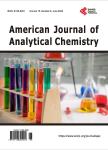Removal of Pb(II) from Aqueous Solution by <i>Portulaca oleracea</i>Leaves: Kinetic, Equilibrium and Thermodynamic Studies
Removal of Pb(II) from Aqueous Solution by <i>Portulaca oleracea</i>Leaves: Kinetic, Equilibrium and Thermodynamic Studies作者机构:Faculty of Education Sebha University Sabha Libya
出 版 物:《American Journal of Analytical Chemistry》 (美国分析化学(英文))
年 卷 期:2013年第4卷第7期
页 面:27-32页
主 题:Portulaca oleracea Langmuir Freundlich Isotherm Lead Adsorption
摘 要:Portulaca oleracea leaves are tested as an agriculture adsorbent material for reducing Pb(II) from aqueous solutions. The pH of solution, adsorbent dose, shaking speed and particles size of adsorbent were constants at all adsorption experiments. Effects of contact time on adsorption capacity of Pb(II) onto Portulaca oleracea leaves were studied. The adsorption capacity increased as the contact time increased and reached equilibrium at one hour. Kinetic models including a first-order, pseudo-second-order and intra-particle diffusion equations were selected to follow the adsorption process. The process follows a pseudo-second-order kinetic and the intra-particle diffusion is the main step to interpret the mechanism of adsorption. Langmuir, Freundlich and Dubinin-Radush Kevich (D-R) isotherm models were applied to describe adsorption equilibrium data. Results proved that the Langmuir isotherm model gave an acceptable fit to the experimental data more than Freundlich isotherm model. Maximum adsorption capacities obtained were 192.3, 333.3 and 434 mg/g at 295, 303 and 310 K, respectively. According to D-R isotherm data, the adsorption process is classified as physical adsorption. Thermodynamically, the adsorption process is non spontaneous, endothermic and random in nature.



